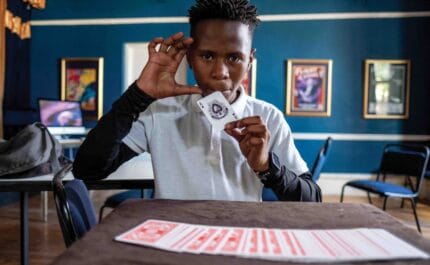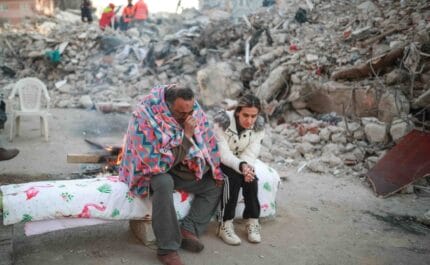Crossing the void: retrieving the bodies along America’s deadly southern border
Each year tens of thousands of Mexican migrants set out to cross the vast Sonoran desert which straddles the border between the US and Mexico. Many do not make it through. As Donald Trump signed an executive order to build a wall along the frontier, Susan Schulman charted the human cost of this most punishing of journeys

David Garcia looks for the bodies of Mexican migrants in the Sonoran desert. Photo: Susan Schulman
Photography by Susan Schulman
25th January 2017 (Taken from: #26)
“This is where we go to find bodies,” says David Garcia. The desert spreads out, vast and silent, all around us. Jagged mountain ridges rise in the distance. “There are lots of them out there.”
We head towards a grove of scrubby, parched bushes. The crusty sides of narrow parched gullies unexpectedly give way underfoot, slowing our progress in the seemingly flat terrain. Galaxies of small stones push uncomfortably through the soles of my shoes.
It’s only 10.30am on a winter’s morning but the sun is already searingly hot. “I try to put myself into the migrant’s shoes – I think where they would be headed and where they wouldn’t get caught…” says Garcia. His words trail off as we duck through the bushes and drop into the wide sandy dried river bed, known here as an arroyo.
Two black plastic gallon water jugs lie discarded on the shallow bank of the arroyo, abandoned by migrants who passed through here around two days earlier by Garcia’s estimate. Picking one up, he turns it over. Thick, filthy water pours out – water the migrants have scooped up from cattle troughs.
As we climb out of the river bed into the open desert, a surge of wind swirls the motionless air into an eerie high-pitched whoosh. Mini tornadoes of dust dart and jump; Garcia’s long grey hair flies, glowing in the sun.
We head towards a red speck, brilliant against the monochrome of the gravelly earth. It is a brand new toothbrush, bought for a brand new life. Nearby are a couple of nearly-new tubes of toothpaste. A pair of reading glasses. A spool of thread. A blister pack of ibuprofen. Three of the carpet-bottomed slippers worn by migrants to erase their footsteps. All scattered, abandoned on the sand under the burning sun.
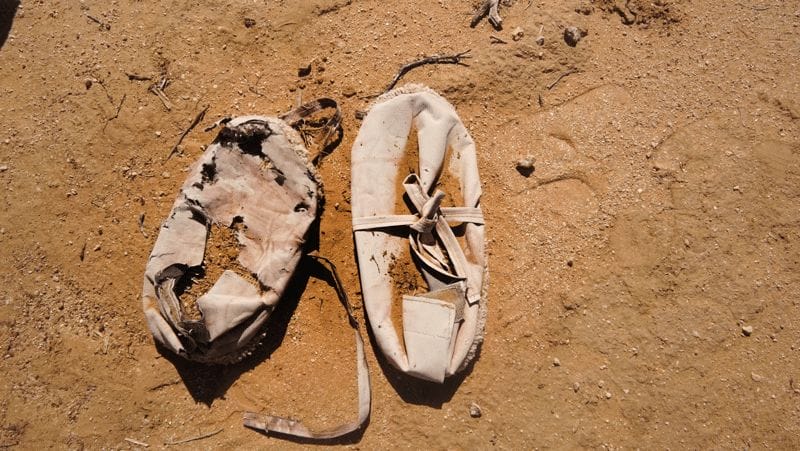
Photo: Susan Schulman
The wind dies down as quickly as it came.
We are in the far south of Arizona in the American part of the vast Sonoran Desert, which straddles the US and Mexico. There’s a spectral beauty to the place. Steep, rocky mountains meet rattlesnake-filled desert studded with the 20-foot saguaro cactus, and when the sun sets the mountains glow purple, an incarnation of the “purple mountain majesties” exulted in the song America the Beautiful. But it is a deadly landscape: temperatures in the summer sun reach 49 degrees Celsius and plunge to freezing in winter nights, and settlements are few and far between.
An estimated 170,000 migrants attempted to cross the Sonoran Desert from Mexico to the US in 2015; 64,000 were apprehended. An unknown number of others died from exposure attempting the gruelling six-day journey over the arduous terrain and under the blistering sun, all at the unforgiving pace set by guides known as coyotes. In 2016, 156 undocumented migrant deaths were recorded in this area alone by the Pima County medical examiner’s office.
And these are only the ones they know about. Three thousand migrants remain unaccounted for and presumed dead on the books of the Colibri Center for Human Rights, a local organisation dedicated to helping families find their loved ones. There are likely to be many more.
The majority of their remains will be here, on the Tohono O’odham Nation reservation. A map produced by the humanitarian organisation Humane Borders in association with the Pima County office of the medical examiner is filled with red dots signifying the location of known migrant deaths in the local area. There are so many that they merge into a single deep red stain.
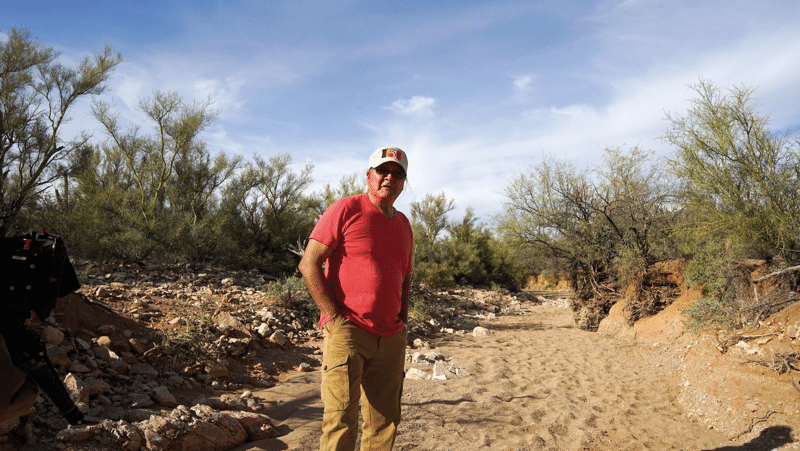
David Garcia swelters under the Arizona sun at the Tohono O’odham reservation. Photo: Susan Schulman
David Garcia is from this area. He grew up riding horses over the reservation, a vast and sparsely populated area covering nearly 5,000 square miles of sacred land that has been home to the tribe since time immemorial and which runs along 72 miles of the border with Mexico.
He doesn’t ride horses any more. Instead, since 2008, he has spent time helping families who are searching these vast lands for the remains of their missing loved ones. For these families, not knowing their fate is a prolonged and devastating form of torture. But finding a body is not easy in an area the size of Connecticut, and all Garcia has to go on is the information a family can give him.
A family might have been told by other migrants travelling in the same group that their loved one has died on a mountain, or in an arroyo, but this information is of little use in a landscape riven with arroyos and thronged with mountains. The search is made even more difficult by the fact that when migrants die their companions move their bodies far from the trail, so as not to bring attention to the route they are using.
“It’s like looking for a needle in a haystack,” admits Garcia. He can spend as long as two weeks tracking the trace footprints, snapped branches, and other tell-tale signs left behind by migrants before he finds the remains. If, that is, the trail doesn’t go cold. It is heartbreaking either way.
Garcia points to Baboquivari mountain. The 7,730-foot sheer granite peak is the most sacred spot for the Tohono O’odham tribe and home to its creator god, I’itoi. “You have blood on your hands when you know people are dying on the reservation, on our sacred land,” he tells me.
Human traffic
The baby looks about three months old – you can just make out the fingers of a hand holding up his head for the photo. He is wearing a powder blue shirt with a Peter Pan collar, closed at the top with a single button, and a matching powder-blue hooded jumper. He has big deep-brown eyes, darker and more soulful than those of his mother in the next picture.
She looks to be in her early twenties. Her brown hair is pulled back tightly. A solitary strand curls rebelliously under her ear and a delicately beaded necklace drops behind her red embroidered blouse. Her mouth turns down apprehensively. The baby gets his dark good looks from his father, a young man with eyes full of determination and warmth and a clutch of bank cards to show for his hard work so far.
We want to get answers for the family. We try to ensure people get the necessary documents and can have a funeral”
Ciro Castro Grande and Natividad Vidal Palma are two young parents working hard for a better future. Only that future will never come. And we don’t really know who they are – we don’t know if they are who their voter registration cards say they are, if the addresses on them are real – or if they are even Mexican. We do know, however, that they died while crossing the Sonoran Desert in Arizona in 2016.
We know that whatever remained of their bodies ended up on a cold steel table in the Pima County office of the medical examiner, where a forensic autopsy conducted under a harsh light concluded that the cause of death was exposure.
Thus death was certified and the few belongings found with their remains – the photos, bank cards, a receipt from a bicycle shop (Bicipartes Joqui, Ayutla De Los Libres, Guerrero, Mexico), the used stub of an airplane boarding card (seat 20b, leaving Acapulco at 7.54am), a woman’s gold ring, a ruby-coloured stone set on its thin band – were placed in a long plastic sleeve.

The belongings of a family of migrants who died while trying to cross the desert. Photo: Susan Schulman
The sleeve was marked ‘16-1822’ and placed into an orange locker already jammed tight with identical sleeves holding the possessions of other migrants who met the same fate. There are eyeglasses. To-do lists. Condoms. Tiny baby socks. Good luck amulets. Knots of hair. Rattlesnake tails. Wallets embossed with the names of favourite football teams and dozens of written prayers imploring the Virgin Mary to pardon sins and bless the journey.
All of them are soaked in fluids absorbed from decomposing bodies and pungent with the choking odour of death. The remnants of the hopeful lives of the young family, whoever they were, made me gag.
Seventy percent of presumed undocumented migrants arrive decomposed”
Next to the room filled with the padlocked orange lockers, a skeleton has been laid out on a table. This is body 17-0066, found on the desert sands in 2017.
The vast majority of migrant remains found in Arizona end up here under the forensic scrutiny of Dr Greg Hess, the Pima County medical examiner. Once he and his team have ascertained the cause of death and filed a report, the main task begins – attempting to identify the deceased. “We want to get answers for the family,” says Dr Hess. ‘‘We try to ensure people get the necessary documents and can have a funeral.”

Pima County medical examiner Dr Greg Hess attempts to identify a skeleton. Photo: Susan Schulman
Much depends on the condition of the remains. “If they are in good condition – ‘fully fleshed’ – we can tell a lot about them,” explains Dr Hess. “If they are fully fleshed, we assume that they were found within a day or two of dying. We try to identify how tall they are, whether they are a man or woman, their prior surgical procedures, tattoos, fractures. We collect all the info, make a profile and try to marry it with the missing persons reports.”
But that is the best-case scenario. If someone dies in summer in Arizona, their body can become skeletal within three weeks. “Seventy percent of presumed undocumented migrants arrive decomposed,” says Dr Hess.
Dirt from the brown, desiccated bones of body 17-0066 flecks the white sheet underneath. The spinal column is incomplete; the left lower leg bone and right lower arm are missing. The pelvis is in two parts and the pieces of bone are set apart like an un-joined jigsaw, but the skull is intact. “The pelvis tells the gender,” says Dr Hess, picking up a piece and turning it over in his gloved hand. “This was a man.”
He examines several vertebrae and points to their edges. ‘The lipping on the spine is a sign of wear and tear,” he says. “He probably had back issues – I’d guess he would have been between 30 and 40.” He picks up the skull and checks it for missing teeth. “We will examine the skeletal remains and a forensic anthropologist will have a look at the bones and create some sort of profile,” he says. “Then we will reach out to other agencies.”
While the medical examiner’s office creates a profile from the forensic evidence culled from the dead, the Colibri Center for Human Rights in Tucson creates a missing persons report from information provided by families desperate to locate their loved ones. The reports are stored in the organisation’s unique online database and then run for a match against the forensic profile created by Dr Hess’s office. Around 45 percent of those for whom a missing persons report is made are never identified.
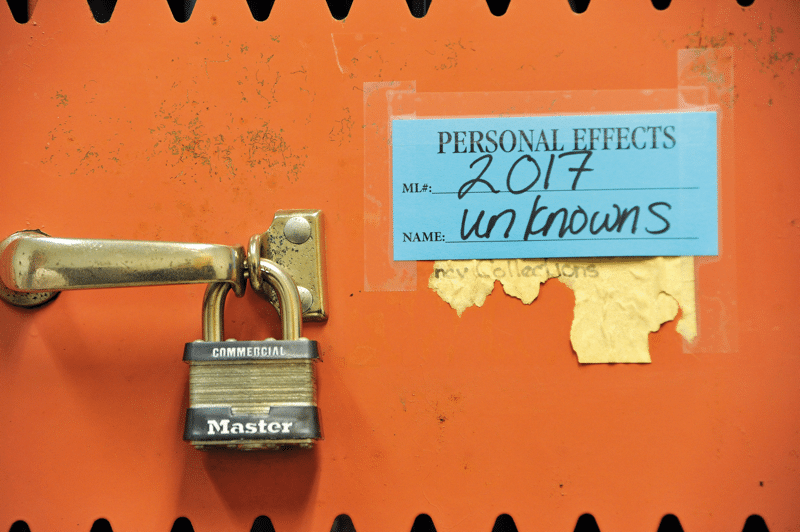
Photo: Susan Schulman
Death and the desert
“When you lose someone, there’s such a range of emotions,” explains 27-year-old Chelsea Halsted, in her office at the Colibri Center. “The problem is that in the absence of information, every horrible thing imaginable is possible – and every day that the person is missing, it plays out. It is a really unique torture.”
Between 2001 and 2016, 2,620 recovered remains of suspected border crossers were examined by the Pima County office of the medical examiner. For the families of the 900 which remain unidentified, life is an endless purgatory in which hope vies with despair. For the families of the 850 whose remains have been disposed of, the purgatory will be permanent. They will die not knowing.
As for the unidentified bones and possessions of Body 17-0066, of ‘Ciro’ and his young family and the 151 ‘John Does’ which currently cram the orange lockers and fill the body bags at the Pima County office of the medical examiner, there is still hope that efforts to identify the remains will enable closure for their families.
It wasn’t always like this. Back in the early ’90s, before the border was militarised, crossing was easy. People would enter the US through the major population centres of border towns. It was safe: there were no more than ten to 15 deaths a year.
The North American Free Trade Agreement (Nafta) of 1994 marked a turning point. Heavily subsidised corn and other staples flooded the Mexican markets, devastating the Mexican farming economy and compelling more and more people to cross the border in search of work. The New York Times cites a figure of two million Mexicans being forced to leave their farms since Nafta was signed.
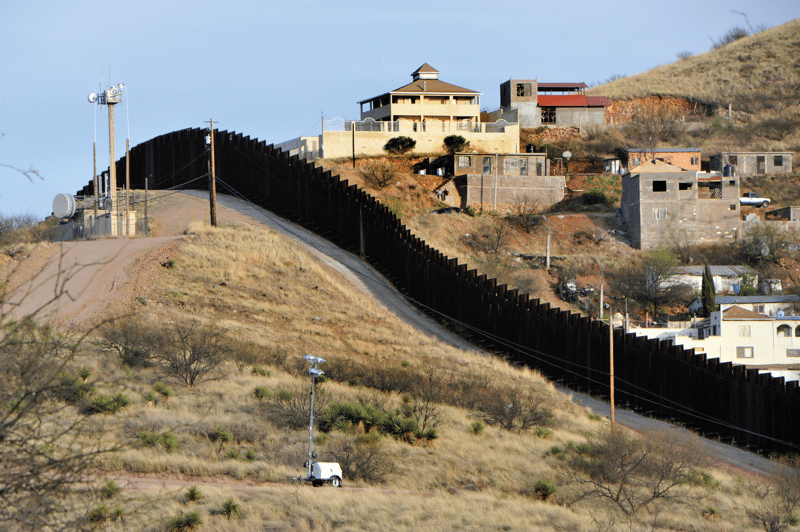
Photo: Susan Schulman
In response, border security was strengthened. Fences, put up as deterrents, pushed migrants into crossing in unfamiliar, remote areas and the crossings became dangerous. By 2002, migrant deaths had rocketed to an average of 171 a year. In 2010, 223 died – 50 in July alone. Migrants were dying from exposure on journeys over hazardous, isolated terrain.
When the crossing became dangerous, they needed people to take them across. A new market had been created, of those desperate to cross the border to be able to work and provide for loved ones.
Recognising a lucrative opportunity, organised crime stepped in. Criminals charged migrants tens of thousands of dollars to be guided across the desert by unscrupulous ‘coyotes’, guides who rob the migrants, abandon those who are struggling and so routinely rape the women under their care that female migrants take birth control pills before setting out.
At every turn, the families are exploited – it’s unimaginable… People don’t really understand the scale and intensity of the crisis here”
For families whose loved ones go missing crossing the desert, grief isn’t the only problem. Up to 80 percent of them find themselves victims of extortion by the coyotes, which can go on for months and sometimes even years. Told that the lives of their loved ones hang in the balance, desperate families pay vast sums of money in ransom. Some have given over their life savings – invariably in vain.
“In all these years, I have never once spoken to a family and never heard in our organisation or any other of anyone who had paid the money and had a missing loved one returned to them,” says Halsted. “The layers of vulnerability and exposure that families go through is just horrifying. At every turn, they are exploited – it’s unimaginable. It’s every sort of trauma,” she exclaims. “I think people don’t really understand the scale and intensity of the crisis here.”
The unambiguous identification of missing migrants is the only way for families to get closure. For some, it might also be the only way to end the extortion.
At the end of 2016, Colibri was able to add the valuable tool of DNA to its arsenal. It is an important step: DNA will be able to conclusively match remains to families. The quest to obtain the necessary counterpart DNA samples from families began in December 2016. Over the next three years, Colibri plans to visit five different cities a year to collect samples from families.
A place in the sun
A 20-foot-high rust-coloured slatted steel fence divides sleepy Nogales, Arizona (population 20,407) from its Mexican counterpart (population 212,533). The fence’s reptilian spine snakes behind the golden arches of McDonald’s, a fluttering American flag, countless shops offering cambio and up and over the umber hills, undulating into the distance as far as the eye can see. Behind it, through the slats, in Mexico, kids are kicking a football.
As I approach one of the small white pickup trucks of the border patrol, parked at intervals next to the fence, the agent inside amiably rolls down his window and we start chatting. He points to a yellow house at the top of the hill next to the fence in Mexico. “See that yellow house? And those ones…” He pauses, pointing to a fuchsia-coloured house ten metres away from us on the other side of the fence and a pink one about 500 metres further down. “Those are the cartel’s houses.”

American border guards on patrol in the Tohono O’odham reservation, Arizona. Photo: Susan Schulman
I watch through the slats as two young girls return from school swinging their backpacks and disappear behind the door of the fuchsia house. “And look over there,” says the agent, gesturing at the hill receding beyond the yellow house. “Their spotters are on the other side of that hill. There’s usually about eight to ten of them, watching us. When they see us move away, they know it’s safe for them to move drugs and migrants across the border,” he says. I had not expected the cartels to be so blatantly, tauntingly, present. But south of the border is their turf.
Down the road in the Samaritans-run El Comedor in Nogales, Mexico, 20 men and five women are being warned of the dangers of these cartel members. They are seated at long wooden tables under a mural of the Last Supper and their upturned, anxious faces are focused intently on a small woman with a microphone.
“Don’t walk alone – people know you’re a migrant,” she says, tracing out the dangers from both cartels and corrupt law enforcement. “Do not go up to the border fence as it is controlled by the cartel – they will ask you for money and if you don’t have it, they will beat you, hit you, assault you…” she warns.
El Comedor is the first stop for those newly deported from the US by law enforcement agencies. Here they get a meal, counsel and medical attention if needed. Many who come here will not accept defeat. They will remain determined to cross again despite the potentially lethal risks and will simply wait for another opportunity, often sleeping in the graveyard under the shadow of the fence until the time comes.

A restaurant in Nogales, Mexico. The map on the right cautions migrants about the dangers of attempting to cross the border through the desert. The text reads ‘Don’t go! There’s not enough water! It’s not worth it!’ Photo: Susan Schulman
Tomasa Mendoza Antonio, 45, first jumped the border fence and crossed the desert in 2000 when she was bringing up four children on her own, the youngest of whom was only two years old. Since then, she has spent nine months a year in Mesa, Arizona, working three cleaning jobs, for 20 hours a day and earning between $5.50 and $6 an hour. Everything she has earned, she has sent back to her children in Mexico, returning home to spend three months of the year with them.
Over that period of time, she has crossed the desert 18 times. ‘It has to be a record!’ she exclaims, a gap-toothed smile spreading across her face.
You know how a chicken runs to feed its chicks? That’s how I ran across the desert”
Each time she made the journey to the US, the coyotes would rob her, taking her belongings and the money she’d brought with her. Each time she would run out of water and food and fight to put one foot in front of the other, knowing that if she struggled or faltered, the coyotes would abandon her, just like they had done with the migrants whose bodies they would pass on the way. And each time, after she arrived in the US, the cartels would call her and attempt to extort even more money.
Why did Tomasa accept such a life? “You know how a chicken runs to feed its chicks?” she says with a smile. “That’s how I ran across the desert – I travelled with painkillers and my strength is my kids. The need to help my children and make sure they are eating is more important than anything.”
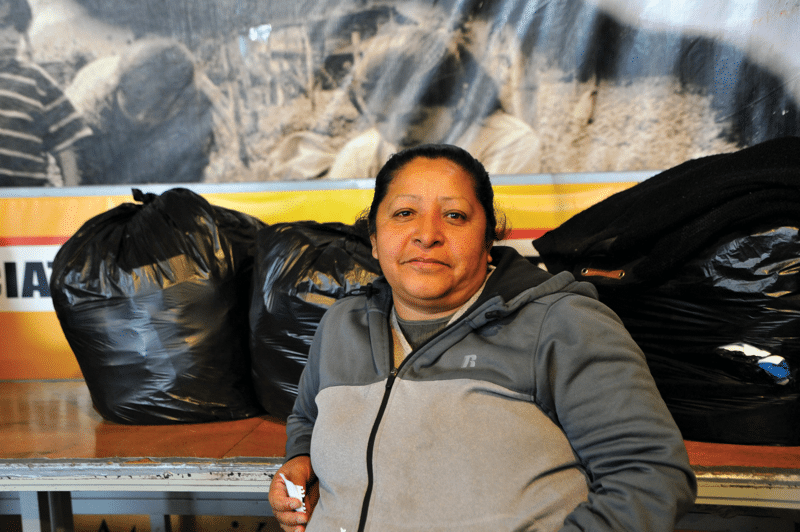
Tomasa Mendoza Antonio in El Comedor in Nogales, Mexico. She has been making the perilous journey to the US through the Sonoran desert since 2000. Photo: Susan Schulman
“Everything I have, I owe to the US,” Tomasa declares. “Because of the US I was able to feed and educate my children.” But President Trump wants to change the US. It remains to be seen whether he fulfils his dream to replace the existing stretches of border fence with a wall that runs the length of the country, but his blistering invective, demonising and threatening migrants, has already taken a grave toll.
Fear in the Latino population in the southern US has escalated precipitously. People desperate to find loved ones have been fearful of making even a 15-minute journey to the DNA collection point in case they are intercepted and deported. Others are afraid to let their children go to school or the supermarket. Afraid that any contact with law enforcement might result in deportation, Latinos who are illegal residents are shrinking from reporting crimes and testifying in court. Yet as fear isolates a population from interactions with law enforcement, impunity grows, strengthening the hand of the extortionists and those eager to prey on the vulnerable – in other words, the very cartels targeted by US law enforcement.
If Trump builds his wall and further increases the fortification of the border, the rate of death can be expected to rise”
Over the years, the trend in the number of migrants crossing the border from Mexico into the US has been downwards. A new study by the Department of Homeland Security shows that the numbers crossing in 2015 were a tenth of those who crossed in 2005. Yet the proportion of migrants who die during the border crossing today is five times what it was back then.
If Trump builds his wall and further increases the fortification of the border, the rate of death can be expected to rise, even if the numbers crossing are further reduced, as migrants are pushed into taking ever more dangerous routes. And increasing the difficulty of the journey from Mexico to the US won’t stop those determined at all costs to make a better life for their children. It didn’t stop Ciro and Natividad.
It didn’t stop any of 3,000 unidentified migrants on Colibri’s books; nor any of the 2,620 whose remains have passed through the Pima County office of the medical examiner since 2001. And it won’t stop mothers, like Tomasa.
“That’s what a mother does for her kids,” she explains. “You’d do it too. It’s not the mind guiding you, it’s your heart.”
Slow Journalism in your inbox, plus infographics, offers and more: sign up for the free DG newsletter. Sign me up
Thanks for signing up.
